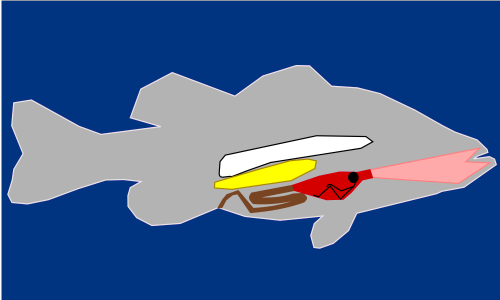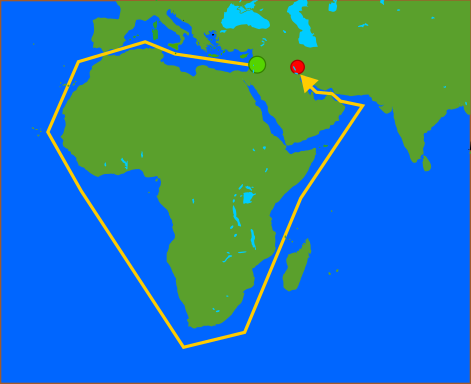
The example of Jonah starts with an impossible journey and concludes with he miraculous repentance of an ungodly nation. It is our story and it parallels the death and resurrection of Christ. For more on how this fits in with the pattern of our lives look at Passover to Shavuot.
The Example of Jonah
We saw earlier that God established timing related to the Passover from the beginning. It is reasonable to expect that if a symbol representing the Passover is supplied then it would conform to the previously established framework. In other words it would not be surprising if the timing of the Jonah episode matched with the events of the crucifixion. While we cannot give definite proof we can certainly demonstrate that the possibility is undeniable. From Matthew we see that Christ repeatedly said that the only sign he would give of his genuineness would be His remaining in the body of the earth in the same way that Jonah was in the belly of the great fish but it is also recognised by others like Luke.
So what did happen to Jonah? What is the example that he left?
First of all it would be surprising if Jonahs actions had nothing to do with Isaiah 36-37 where we see Sennacherib king of Assyria as the antagonist against Israel. God eventually intervened in chapter 37:21-38 and sent him packing back to his capital Nineveh where (seventeen years later according to some historians) he met an untimely end. If this was the motivation for Jonah's actions then they would not at all be surprising but the vindication of Jonah is not the subject of this installment but rather to show that if is entirely possible that the events of Jonahs ordeal exactly parallel those of the crucified Christ as far as the time spent in the grave is concerned.
It is fairly easy to broadly date the incident when you consider that king Sennacherib reigned from 704-681 BC. The reign of Jeroboam II was prosperous for Israel and there was not threat from Assyria then but the book is typically dated as coming from that time. I think that it immediately followed the reign of Jeroboam II and probably followed the great earthquake recorded by Amos. That event would have weakened Israel and also put fear of the true God in the hearts of surrounding nations like Assyria. Assyria would have become a serious threat to weakened Israel and Jonah might well have understood their potential. Isaiah started to peach in Judah during the reign of Jeroboam II which means that all these events in Israel occurred in his time. It is likely that they occur during the threat of Assyria. Assyria eventually took Israel captive over a period of about 20 years. I suspect that Jonah saw the threat of Assyria and that is why he was so reluctant. But there are other interesting anomalies.

The stomach of a fish is small by comparrison to the size of the fish. The image used in my introduction is a reasonable representation and you can check wikipedia
The Tigris river, which flows past Nineveh is relatively shallow and very busy. It seems to have always been a thoroughfare for trade. The point here is that the river is relatively shallow and busy and would not conceal a large sea animal. Considering the anatomy of a fish it would have to be the size of a house. With the traffic on the river such a large creature would have to travel by night not to cause an instant commotion and let the cat out of the bag. Even then it could not get close to Nineveh because the water was too shallow. If the creature was seen the repentance would then be attributed to some fish-god and not to Jonahs preaching. In addition it is unlikely that the river could support the creature swimming close to Nineveh and so Johan would have to be spewed out some distance away and walk the rest. All of this supposition is however is not even worth considering if we have no method of reaching the Nineveh from Joppa in three days. It was impossible then and had to be a miracle.
The Key elements are in Jonah Ch 1
Let us pause for a quick review of what happened. Jonah got word from the Lord to warn Nineveh (v1-2) but Jonah bolted (v3). He went straight to the docks and caught a boat to Tarshish. This seems to have been a deliberate act to get as far away from God as possible because Tarshish seems to have been a long distance away. In other words Jonah did not catch the first available boat, he wanted to get as far away from God as possible.
II Chronicles 9:20-21 KJV And all the drinking vessels of king Solomon were of gold, and all the vessels of the house of the forest of Lebanon were of pure gold: none were of silver; it was not any thing accounted of in the days of Solomon. 21 For the king’s ships went to Tarshish with the servants of Huram: every three years once came the ships of Tarshish bringing gold, and silver, ivory, and apes, and peacocks.
There is another very important thing to note. God uses water to represent death. It developed from the flood. The flood represented the destruction of all life and we join them all symbolically at baptism. If not for the death of Christ we would not be here. He is also represented in baptism as the one that death could not hold and it is He who overcomes death to show power over it and can therefore justly overrule it. He joined us in death but overcame it, demonstrating who is dominant and the dominant one is the one who determines the result.If we are with Him then we too come out safely on the other side. Symbolically then Johan was dead.
We continue with Chapters 2 and 3
From Chapter two we see a sequence of events starting in verse 3 and ending in verse 8. Jonah was cast into the sea and stayed afloat for a while but was overcome by waves. When we compare this with Chapter 1 v11-17 we see that the storm was raging before Jonah was cast into the water but it immediately abated once he hit the water. The billowing therefore lasted only a short time and the sailors saw the calm but probably did not see the fish. Jonah was apparently in the water and splashed around enough to see the water become calm but sank shortly afterward and was swallowed out of the sight of the sailors.
The fish was not a normal fish. It ate seaweed. Seaweed does not grow in very deep water because there is no sunlight. According to Jonah the fish went down to the bottom of the mountains (chapter 2:6). If this is literally what happened then the fish could have used some undersea fissure to reach the Red sea from the Mediterranean Sea. We also see that Jonah was vomited out on dry land and within walking distance of Nineveh. That is only possible if the creature swam through fresh water
Jonah 3:1-10 (KJV) And the word of the LORD came unto Jonah the second time, saying, 2 Arise, go unto Nineveh, that great city, and preach unto it the preaching that I bid thee. 3 So Jonah arose, and went unto Nineveh, according to the word of the LORD. Now Nineveh was an exceeding great city of three days' journey. 4 And Jonah began to enter into the city a day's journey, and he cried, and said, Yet forty days, and Nineveh shall be overthrown. 5 So the people of Nineveh believed God, and proclaimed a fast, and put on sackcloth, from the greatest of them even to the least of them. 6 For word came unto the king of Nineveh, and he arose from his throne, and he laid his robe from him, and covered him with sackcloth, and sat in ashes. 7 And he caused it to be proclaimed and published through Nineveh by the decree of the king and his nobles, saying, Let neither man nor beast, herd nor flock, taste any thing: let them not feed, nor drink water: 8 But let man and beast be covered with sackcloth, and cry mightily unto God: yea, let them turn every one from his evil way, and from the violence that is in their hands. 9 Who can tell if God will turn and repent, and turn away from his fierce anger, that we perish not? 10 And God saw their works, that they turned from their evil way; and God repented of the evil, that he had said that he would do unto them; and he did it not.
Notice: (Ch2 v10) the fish vomited out Jonah on land then God directed Jonah the second time (ch3:1-2). There is no mention that Jonah slept and got up the next day, the events immediately follow each other. (v3) He had a city three days in circumference (according to Eastons Illustrated Dictionary ~ Nineveh) to cover. One often disregarded miracle here is how the fish got from Joppa to the region of Nineveh. Joppa is on the coast of Israel and Nineveh is landlocked in the region of the Tigris. The only water access is through the Sinai Peninsula and there is no way of reaching that unless you go around the tip of Africa. Once there the fish would have to find its way up the Tigris. Some also suggest that there was a canal leading from the Mediterranean into the Red Sea but I have not found it on any map. The Suez Canal which presently holds that distinction was opened in 1869. We can see on the map above that Israel faces the Mediterranean Sea and Joppa was on that coast. A sea Journey to the Persian Gulf would start by going around Morocco then down to South Africa. According to http://www.mapcrow.info/Distance_between_Durban_SF_and_Cairo_EG.html , the distance from Durban South Africa to Cairo Egypt is 4,135.84 miles (6,688.80 Km). Sources on the internet indicate that the fastest species of fish is the Indo-Pacific Sailfish, Istiophorus platypterus. It has been clocked in excess of 68 mph (110 km/h) but that is apparently when it is leaping and would only be for short periods. 4,135 /68 gives us about 61 hours. This gives us a minimum time of 61 hours or two and a half twenty-four hour days if the fish could swim straight down and then it would have to swim back up. No known creature can do it in three days. I mentioned earlier that the fish could have used some undersea fissure but either way it was a miracle.
Jonah immediately left and completed a days journey, which in my opinion brought him to the city, where he began to preach. Some argue that the journey was into the city and Jonah was preaching all the while (v4) whatever the reason, he therefore spent a whole day walking. According to my suppositions Johah would have had to walk considerably to reach Nineveh.
Day's journey From Wikipedia, the free encyclopedia
A Day's journey in pre-modern literature, including the Bible, ancient geographers and ethnographers such as Herodotus, is a measurement of distance.
In the bible it is not as precisely defined as other Biblical measurements of distance; the distance has been estimated from 32 to 40 kilometers (20-25 miles).
In translation by J.B. Bury (Priscus, fr. 8 in Fragmenta Historicorum Graecorum) We set out with the barbarians, and arrived at Sardica, which is thirteen days for a fast traveller from Constantinople. From Constantinople-Istambul to Sofia is 550-720 km distance it give 42 - 55 km /day.wikipedia Day's journeyWikipedia The free encyclopedia WEBversion 02:24, 21 August 2019
Day's journey [EBD] Easton's Bible Dictionary
The usual length of a day's journey in the East, on camel or horseback, in six or eight hours, is about 25 or 30 miles. The "three days' journey" mentioned in Ex. 3:18 is simply a journey which would occupy three days in going and returning.
Easton's Bible Dictionary Days journeyBible Study Tools _ Grow deeper in the word WEBDec 1, 2020
DAY'S JOURNEY [ISBE] International Standard Bible Encyclopedia
DAY'S JOURNEY - jur'-ni (derekh yom, Gen 30:36; Nu 10:33; 11:31; hemeras hodos, Lk 2:44): The common way of estimating distances in the East is by hours and days. This is natural in a country where roads are mere bridle paths or non-existent, as in the desert. The distance traveled must of course differ largely according to the difficulties of the way, and it is more important to know where night will overtake the traveler than the actual distance accomplished. A day's journey is now commonly reckoned at about 3 miles per hour, the distance usually covered by a loaded mule, the number of hours being about 8. Hence, a day's journey is about 24 miles, and this may be taken as a fair estimate for Bible times.H. Porter
International Standard Bible Encyclopedia Day's JourneyBible Study Tools _ Grow deeper in the word WEBDec 1, 2020
I will use 24 miles and I will also suggest that the speed of a loaded pack animal would be dictated by how fast a person leading him could walk; hence it would be the speed of a person walking. In my opinion such a large creature as would be necessary to swallow Jonah, cruising up such a shallow, busy river in broad daylight would certainly have caused a commotion therefore I believe that Jonah was vomited out under cover of darkness. Of course there are innumerable supernatural possibilities that would render all this logic irrelevant but they would involve making assumptions while this narrative is based solely on the evidence presented in the Bible and the conclusions which would naturally follow. In addition Jonah would have had to leave very early to travel 24 miles before reaching the city and have enough time to preach. There is also an argument that the 24 miles (a days journey) were spent traversing the city but the context indicates that Jonah began to peach after this journey suggesting that it marked his reaching the city. It appears like the fish vomited him out very early in the morning, apparently way before daybreak giving him time to reach the city before people were up and about. Now we can count backwards. Remember that according to Jonah 1:17 he spent three days and three nights in the great fish and now we see that the count ended with a night probably way before daybreak. Continuing to work back then he must have spent two whole days in the fish and therefore the first day had to be the short day. There is no way to account for exactly 72 hours considering when he had to be thrown overboard (maybe late evening give or take a few hours) and when he was vomited out (not late evening and most likely night).
The story of Jonah is miraculous and there is no way to accurately account for the time but two things appear to be clear (one) he was swallowed in the evening (two) he was vomited out under cover of darkness quite a distance from Nineveh. Jonah was in the fish precisely how long God wanted him to be not how long it would normally take for such a trip. It appears to parallel Christs death almost identically by design and Jonah obviously spent no more than three days in the belly of the fish. The first day was part of a day (if he was thrown in around three to five Oclock and paddled around for a while just like Christ would have been buried before the Sabbath). So God continues to represent the same event in the same manner right down to shortly before the real event actually occurred. This is the last of three great symbolic Passovers Adam and Eve covered with skins, Abraham sacrificing Isaac and now Jonah.

